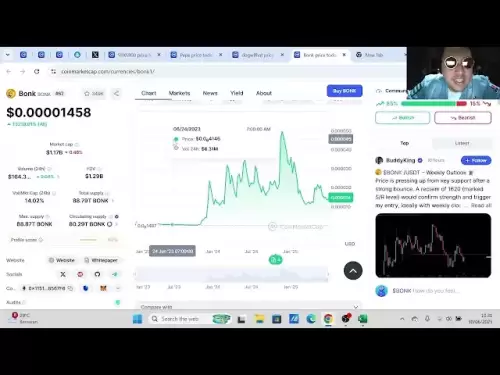-
 Bitcoin
Bitcoin $108,489.6704
1.13% -
 Ethereum
Ethereum $2,502.0528
2.92% -
 Tether USDt
Tether USDt $1.0002
0.00% -
 XRP
XRP $2.1941
0.51% -
 BNB
BNB $655.3375
1.00% -
 Solana
Solana $151.5977
1.27% -
 USDC
USDC $0.9999
0.00% -
 TRON
TRON $0.2768
0.32% -
 Dogecoin
Dogecoin $0.1676
2.86% -
 Cardano
Cardano $0.5675
0.98% -
 Hyperliquid
Hyperliquid $40.6109
7.48% -
 Bitcoin Cash
Bitcoin Cash $500.7746
2.09% -
 Sui
Sui $2.8328
2.03% -
 Chainlink
Chainlink $13.4452
1.26% -
 UNUS SED LEO
UNUS SED LEO $9.1623
0.39% -
 Avalanche
Avalanche $18.2267
2.24% -
 Stellar
Stellar $0.2382
0.00% -
 Toncoin
Toncoin $2.8885
1.68% -
 Shiba Inu
Shiba Inu $0.0...01159
0.91% -
 Litecoin
Litecoin $87.1827
0.88% -
 Hedera
Hedera $0.1511
2.90% -
 Monero
Monero $315.4992
-0.59% -
 Polkadot
Polkadot $3.4663
2.34% -
 Bitget Token
Bitget Token $4.6118
-0.65% -
 Dai
Dai $1.0000
-0.01% -
 Ethena USDe
Ethena USDe $1.0003
0.02% -
 Uniswap
Uniswap $7.2989
4.69% -
 Pepe
Pepe $0.0...01003
5.73% -
 Aave
Aave $275.5616
7.15% -
 Pi
Pi $0.5181
-2.49%
Which technical indicator of THETA is the most accurate? Which is more suitable for analysis, MACD or RSI?
Traders use MACD to spot THETA's trend strength and RSI to identify overbought/oversold conditions, often combining both for a comprehensive analysis.
May 07, 2025 at 02:29 pm
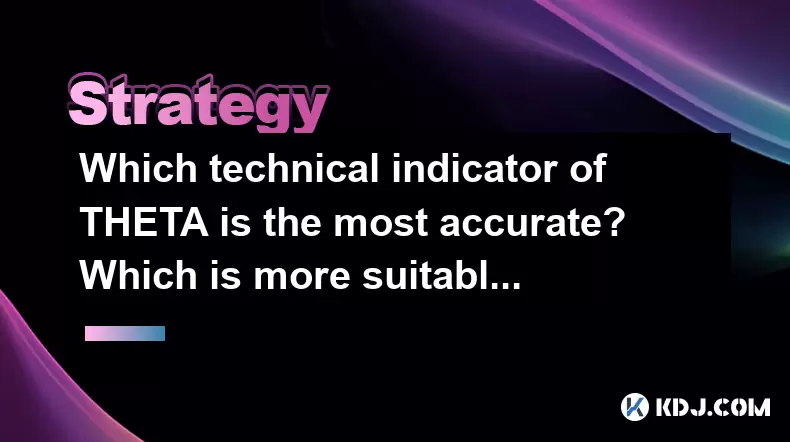
When analyzing the price movements of THETA, a cryptocurrency known for its decentralized video delivery network, traders often turn to technical indicators to gain insights into potential trends and make informed trading decisions. Among the plethora of technical indicators available, two of the most commonly used are the Moving Average Convergence Divergence (MACD) and the Relative Strength Index (RSI). This article will delve into the specifics of both indicators and assess which one might be more accurate and suitable for analyzing THETA.
Understanding the MACD Indicator
The MACD, or Moving Average Convergence Divergence, is a trend-following momentum indicator that shows the relationship between two moving averages of a cryptocurrency's price. It is calculated by subtracting the 26-period Exponential Moving Average (EMA) from the 12-period EMA. The result of this calculation is the MACD line. A 9-period EMA of the MACD, called the "signal line," is then plotted on top of the MACD line, which can function as a trigger for buy and sell signals.
- Bullish Signal: When the MACD line crosses above the signal line, it suggests a potential upward momentum, indicating a possible buying opportunity.
- Bearish Signal: Conversely, when the MACD line crosses below the signal line, it may indicate downward momentum, suggesting a potential selling point.
For THETA, the MACD can be particularly useful in identifying the strength and direction of its price trends. Traders often look for divergences between the MACD and the price of THETA to predict potential reversals. For instance, if THETA's price is making new highs but the MACD is not, it could signal a weakening trend and an impending reversal.
Understanding the RSI Indicator
The RSI, or Relative Strength Index, is a momentum oscillator that measures the speed and change of price movements. It oscillates between zero and 100 and is typically used to identify overbought or oversold conditions in a cryptocurrency's price. The RSI is calculated using the average gains and losses of a security over a specific period, usually 14 days.
- Overbought Condition: An RSI value above 70 suggests that THETA might be overbought, indicating a potential price correction or reversal.
- Oversold Condition: An RSI value below 30 suggests that THETA might be oversold, indicating a potential price bounce or reversal.
For THETA, the RSI can be instrumental in pinpointing potential entry and exit points. Traders often combine the RSI with other indicators to confirm signals. For example, if THETA's RSI is below 30 and starts to rise, it might be a signal to buy, especially if other indicators like the MACD also suggest a bullish trend.
Comparing MACD and RSI for THETA Analysis
When deciding which indicator is more suitable for analyzing THETA, it's important to consider their strengths and weaknesses.
MACD: The MACD is excellent for identifying the direction and strength of a trend. It can be particularly useful for THETA traders looking to follow the trend and capitalize on momentum. However, the MACD may generate false signals during periods of consolidation or when the market is ranging, which can lead to premature entries or exits.
RSI: The RSI, on the other hand, is more effective at identifying overbought and oversold conditions. It can help THETA traders pinpoint potential reversal points, especially when combined with other indicators. However, the RSI can remain in overbought or oversold territory for extended periods during strong trends, which may lead to missed opportunities.
Using MACD and RSI Together for THETA
For a more comprehensive analysis of THETA, many traders use both the MACD and RSI in conjunction. This approach allows them to leverage the strengths of both indicators while mitigating their weaknesses.
- Divergence Analysis: Look for divergences between THETA's price and the MACD or RSI. For example, if THETA's price is making new highs but the RSI is not, it could indicate a weakening trend.
- Confirmation of Signals: Use the MACD to identify the trend direction and the RSI to confirm entry and exit points. For instance, if the MACD indicates a bullish trend and the RSI moves above 30, it could be a strong signal to buy THETA.
- Overbought/Oversold Conditions: Pay attention to the RSI to identify potential overbought or oversold conditions in THETA's price. If the RSI is above 70 and the MACD shows bearish divergence, it could be a signal to sell.
Practical Application of MACD and RSI for THETA
To apply the MACD and RSI effectively for THETA, follow these steps:
- Set Up Your Chart: Open a charting platform that supports THETA, such as TradingView or Binance.
- Add MACD: Navigate to the indicators section and add the MACD. Ensure the default settings (12, 26, 9) are used unless you have a specific reason to adjust them.
- Add RSI: Add the RSI indicator to your chart. The default setting is usually 14 periods.
- Analyze Trends with MACD: Observe the MACD line and signal line to identify bullish or bearish trends in THETA's price.
- Identify Overbought/Oversold Conditions with RSI: Monitor the RSI to identify potential entry and exit points based on overbought or oversold conditions.
- Look for Divergences: Check for divergences between THETA's price and the MACD or RSI to predict potential reversals.
- Combine Signals: Use the signals from both indicators to make more informed trading decisions. For example, if the MACD indicates a bullish trend and the RSI moves above 30, it could be a strong signal to buy THETA.
Frequently Asked Questions
Q: Can the MACD and RSI be used for other cryptocurrencies besides THETA?
A: Yes, the MACD and RSI are versatile indicators that can be applied to any cryptocurrency. Their effectiveness may vary depending on the specific characteristics of the cryptocurrency, but they are widely used across the crypto market.
Q: How often should I check the MACD and RSI for THETA?
A: The frequency of checking depends on your trading strategy. For short-term traders, checking every few hours or daily might be necessary. For long-term investors, weekly or monthly checks could be sufficient.
Q: Are there any other indicators that work well with MACD and RSI for THETA analysis?
A: Yes, other indicators that can complement the MACD and RSI include the Bollinger Bands for volatility, the Stochastic Oscillator for momentum, and the Moving Averages for trend confirmation. Combining multiple indicators can provide a more robust analysis of THETA's price movements.
Q: Can the MACD and RSI be used for automated trading of THETA?
A: Yes, both the MACD and RSI can be incorporated into algorithmic trading strategies for THETA. Many trading bots and platforms allow you to set up automated trading rules based on these indicators. However, it's crucial to backtest your strategy thoroughly before using it in live trading.
Disclaimer:info@kdj.com
The information provided is not trading advice. kdj.com does not assume any responsibility for any investments made based on the information provided in this article. Cryptocurrencies are highly volatile and it is highly recommended that you invest with caution after thorough research!
If you believe that the content used on this website infringes your copyright, please contact us immediately (info@kdj.com) and we will delete it promptly.
- Ripple XRP, Bitcoin, and Solaris Presale: What's the Buzz?
- 2025-06-30 18:50:11
- SpaceX, Mirror Tokens, and Investors: A Wild Ride to the Future?
- 2025-06-30 19:10:22
- Arbitrum (ARB) and Robinhood: Partnership Rumors Fuel Price Surge to $0.4289?
- 2025-06-30 19:10:22
- Jasmy Coin, Bitcoin, and the Rise of Solaris Presale: What's the Buzz?
- 2025-06-30 18:30:12
- XRP, SEC, and Ripple: A New Chapter?
- 2025-06-30 19:15:13
- Arbitrum's ARB Price Surges Amid Robinhood Partnership Buzz: A New York Minute on Crypto
- 2025-06-30 19:30:12
Related knowledge

What are the skills of Bitcoin option hedging? Practical case sharing
Jun 24,2025 at 04:01pm
Understanding Bitcoin Option HedgingBitcoin option hedging is a risk management strategy used by traders and investors to protect their positions in the volatile cryptocurrency market. By using options, individuals can limit potential losses while retaining the opportunity for profit. In essence, it allows one to insulate against adverse price movements...
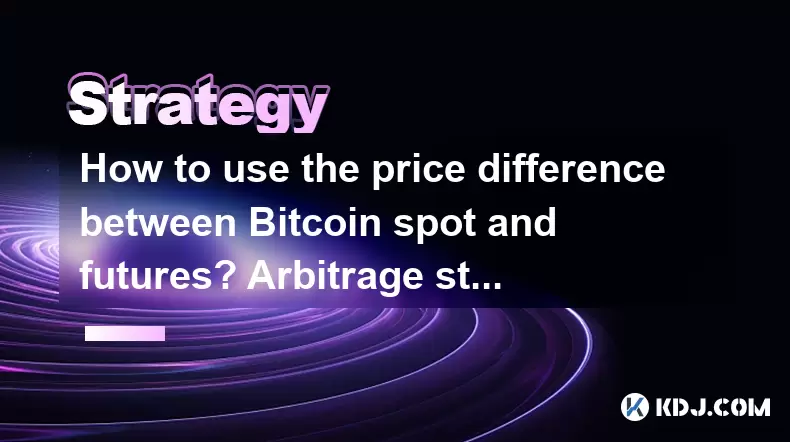
How to use the price difference between Bitcoin spot and futures? Arbitrage strategy
Jun 20,2025 at 02:56pm
Understanding Bitcoin Spot and Futures MarketsTo effectively leverage arbitrage opportunities between Bitcoin spot and futures markets, it's essential to understand the fundamental differences between these two types of markets. The spot market refers to the direct buying and selling of Bitcoin for immediate delivery at the current market price. In cont...
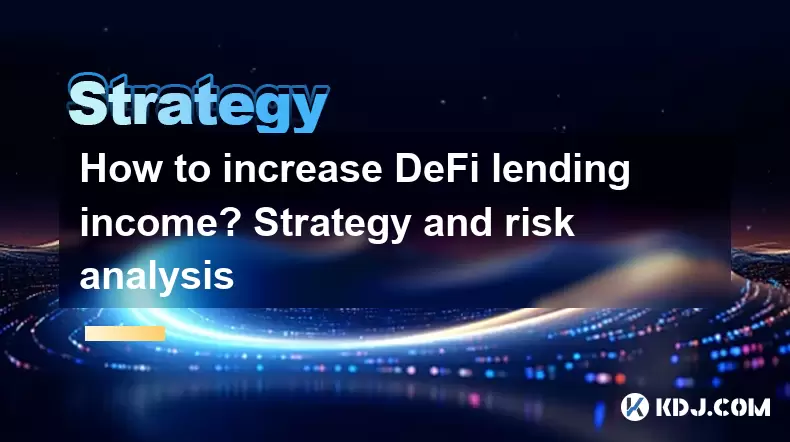
How to increase DeFi lending income? Strategy and risk analysis
Jun 24,2025 at 02:08pm
Understanding DeFi Lending and Its Income PotentialDeFi (Decentralized Finance) lending has emerged as a popular way to earn passive income in the cryptocurrency space. Unlike traditional banking systems, DeFi lending platforms allow users to lend their crypto assets directly to borrowers without intermediaries. The lenders earn interest based on the su...

How to operate cryptocurrency cross-market arbitrage? Practical analysis
Jun 23,2025 at 04:01am
Understanding Cryptocurrency Cross-Market ArbitrageCryptocurrency cross-market arbitrage involves taking advantage of price differences for the same digital asset across different exchanges. The core idea is to buy low on one exchange and sell high on another, capturing the profit from the discrepancy. This strategy relies heavily on real-time market da...

How to make profits from high-frequency cryptocurrency trading? Sharing core skills
Jun 19,2025 at 05:07pm
Understanding High-Frequency Cryptocurrency TradingHigh-frequency trading (HFT) in the cryptocurrency market involves executing a large number of trades at extremely fast speeds, often within milliseconds. This method relies on small price discrepancies across exchanges or within a single exchange’s order book. Traders use complex algorithms and ultra-l...
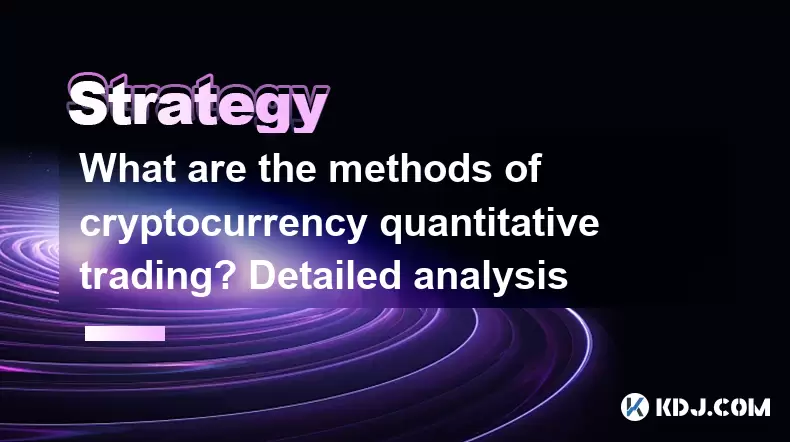
What are the methods of cryptocurrency quantitative trading? Detailed analysis
Jun 22,2025 at 11:07pm
Understanding the Core of Cryptocurrency Quantitative TradingCryptocurrency quantitative trading refers to the use of mathematical models and algorithms to execute trades in the digital asset market. Unlike traditional discretionary trading, which relies heavily on human judgment, quantitative trading leverages data-driven strategies to identify profita...

What are the skills of Bitcoin option hedging? Practical case sharing
Jun 24,2025 at 04:01pm
Understanding Bitcoin Option HedgingBitcoin option hedging is a risk management strategy used by traders and investors to protect their positions in the volatile cryptocurrency market. By using options, individuals can limit potential losses while retaining the opportunity for profit. In essence, it allows one to insulate against adverse price movements...

How to use the price difference between Bitcoin spot and futures? Arbitrage strategy
Jun 20,2025 at 02:56pm
Understanding Bitcoin Spot and Futures MarketsTo effectively leverage arbitrage opportunities between Bitcoin spot and futures markets, it's essential to understand the fundamental differences between these two types of markets. The spot market refers to the direct buying and selling of Bitcoin for immediate delivery at the current market price. In cont...

How to increase DeFi lending income? Strategy and risk analysis
Jun 24,2025 at 02:08pm
Understanding DeFi Lending and Its Income PotentialDeFi (Decentralized Finance) lending has emerged as a popular way to earn passive income in the cryptocurrency space. Unlike traditional banking systems, DeFi lending platforms allow users to lend their crypto assets directly to borrowers without intermediaries. The lenders earn interest based on the su...

How to operate cryptocurrency cross-market arbitrage? Practical analysis
Jun 23,2025 at 04:01am
Understanding Cryptocurrency Cross-Market ArbitrageCryptocurrency cross-market arbitrage involves taking advantage of price differences for the same digital asset across different exchanges. The core idea is to buy low on one exchange and sell high on another, capturing the profit from the discrepancy. This strategy relies heavily on real-time market da...

How to make profits from high-frequency cryptocurrency trading? Sharing core skills
Jun 19,2025 at 05:07pm
Understanding High-Frequency Cryptocurrency TradingHigh-frequency trading (HFT) in the cryptocurrency market involves executing a large number of trades at extremely fast speeds, often within milliseconds. This method relies on small price discrepancies across exchanges or within a single exchange’s order book. Traders use complex algorithms and ultra-l...

What are the methods of cryptocurrency quantitative trading? Detailed analysis
Jun 22,2025 at 11:07pm
Understanding the Core of Cryptocurrency Quantitative TradingCryptocurrency quantitative trading refers to the use of mathematical models and algorithms to execute trades in the digital asset market. Unlike traditional discretionary trading, which relies heavily on human judgment, quantitative trading leverages data-driven strategies to identify profita...
See all articles























